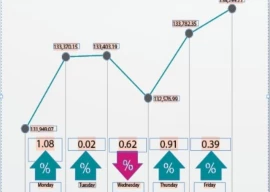
This trend is common except in the case of specialised banks, where it has decreased. All public sector commercial banks, private banks and foreign banks have registered a 100% increase in the NPL stock.
In fact, the NPL in foreign banks has increased from 1% to 11%. The rising NPL has also affected the capital base of banks. According to the State Bank of Pakistan, NPL now accounts for 28% of the capital owned by public sector commercial banks, which was just 3.4% seven years ago.
In the case of private banks, this is less worrisome. NPL accounts for 8% of their capital base, up from 4%.
The stock of NPL has now gone up to Rs600 billion, of which around Rs500 billion is considered to be arising out of business loss, which should invite the attention of analysts to understand its composition. According to the SBP, the SME and agriculture sectors accounted for 50% of infected loans over 2013-14.

Ironically, after-tax profits across the industry have increased over the last seven years, by three times, from Rs43 billion to Rs115 billion. The rising NPL and enhanced profits can only be explained by one factor: risk-free lending to the federal government. Thus, 89% of all investments by commercial banks are made in government securities.
How the government repays its rich domestic lenders? This should surprise no one by now: by borrowing more. A government which is not able to raise taxation level significantly, or come out of subsidising loss-making enterprises, or settle the circular debt, only has one option to repay its creditors: borrow more. This relationship between commercial banks and the federal government is potentially a large Ponzi scheme, which will ultimately hit all players.
Catching small fish
Probably, there is nothing that the SBP can do to check this self-defeating Ponzi scheme except to go for small fish. By placing a moratorium on KASB for six months, ie, placing a ceiling over withdrawals, it has exactly done this.
It has been argued that from a deposit base of Rs62 billion, the KASB management lent Rs33 billion, Rs14 billion of which was declared as NPL, which still stands at Rs11 billion after some recoveries. Furthermore, an NPL provision of Rs8.5 billion actually eroded the capital base of the bank.
Whether the SBP’s action will help in recovery or not, it will have one certain consequence, uncertainty on the part of the depositors who, once the ban is lifted, will psychologically prefer larger withdrawals. This may already have an effect on the depositors in other banks. Financial history of the world calls it a bank run.
Thus, the decision to place a ceiling of Rs300,000 on deposit withdrawal for the purpose of depositor protection may result in the exact opposite. This is what happens when the government imposes price ceilings. The financial industry is no exception to sound economics.
On the other hand, if most of the sanctioned loans by a private bank management have to be written off as NPL, then the bank’s management needs a day of reckoning. The sponsors are actually barred from credit decisions.
In the days of state ownership, perhaps there was an excuse. However, now that banks are in private hands, one needs to see if political intervention at any level, including from the central bankers, has any relationship with such staggering amount of NPL in just one bank or it is just a case of moral hazard.
Negative bearing
The SBP’s decision in the specific case of KASB will have other negative externalities as well. It is likely to have a negative bearing on whatever little yet solid investments that have come from Chinese sources in the last couple of years.
KASB brought $40 million of Chinese investment in 2012. Now the Chinese shareholders are highly uncertain about their own status and have expressed dismay.
Chinese investors do rightly fear that the SBP may hand over the bank to an acquirer by just going on the book value basis whereas financial gains to the acquirer could be over Rs10 billion.
Punishment not protection
If the global financial crisis of 2008 has any one lesson, it should be this: irresponsible banking needs punishment instead of protection. Private bankers advancing loans without due diligence should be held individually responsible for an unusually large NPL and they should not be allowed to shield behind the corporate person.
At the same time, the central government’s borrowing from commercial banks needs very strong checks as well. As a matter of principle, bankers’ losses, just as their profits, cannot be socialised. Under the present high NPL, government borrowing from banks is actually socialisation of banks’ losses.
The writer is the founder of PRIME Institute, an economic policy think tank based in Islamabad
Published in The Express Tribune, December 29th, 2014.
Like Business on Facebook, follow @TribuneBiz on Twitter to stay informed and join in the conversation.


















COMMENTS
Comments are moderated and generally will be posted if they are on-topic and not abusive.
For more information, please see our Comments FAQ